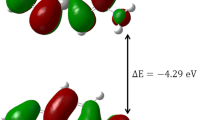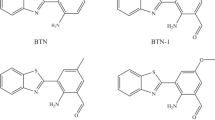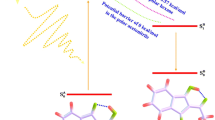Abstract
The furo[2,3-b]pyridine moiety is an important scaffold for many biologically active compounds, therefore, the spectral data of the derivative 1-(3-Amino-6-(2,5-dichlorothiophen-3-yl)-4-phenylfuro[2,3-b]pyridin-2-yl) ethenone (FP1) were investigated. Analysis of absorption-pH profile and Förster cycle of FP1 revealed that its excited state is more acidic than its ground state (\(p{{K}_{a}}^{*}\) < \(p{K}_{a}\)). The main fluorescence emission band of FP1 at 480 nm (in hexane) is shifted to longer wavelengths with increasing polarities of solvents. Linear Lippert’s plot and linear correlation between bands maxima and Camlet-Taft parameter, α, of the protic solvents indicated efficient intramolecular charge transfer and noticeable H-bonding. Moreover, the disappearance of the absorption band of FP1 at 385 nm in water, along with the noticeable red shift and quenching of the emission band, and the lower lifetime, relative to nonaqueous solvents, indicate the interruption of the furo[2,3-b]pyridine aromatic moiety. In addition, results from the Time Dependent Density Functional Theory (TDDFT) and Molecular Mechanic (MM) calculations were in agreement with experimentally determined spectra of FP1.











Similar content being viewed by others
Data Availability
“Not applicable”.
Change history
14 June 2023
A Correction to this paper has been published: https://doi.org/10.1007/s10895-023-03294-0
References
-Abdel-Rahman AAH, Shaban AKF, Nassar IF, EL-Kady DS, Ismail NSM, Mahmoud SF, Awad HM, El-Sayed WA (2021) Discovery of New Pyrazolopyridine, Furopyridine, and pyridine derivatives as CDK2 inhibitors: design, synthesis, Docking Studies, and anti-proliferative activity. Molecules 26:3923. https://doi.org/10.3390/molecules26133923
-Němec V, Hylsová M, Maier L, Flegel J, Sievers S, Ziegler S, Schroeder M, Berger BT, Chaikuad A, Valčá¼°ková B, Uldrijan S, Drápela S, Souček K, Waldmann H, Knapp S, Paruch K (2019) Furo[3,2-b]pyridine: a Privileged Scaffold for highly selective kinase inhibitors and effective modulators of the hedgehog pathway. Angew Chem Int Ed 58(4):1062–1066. https://doi.org/10.1002/anie.201810312
-Kumar RN, Poornachandra Y, Nagender P, Mallareddy G, Kumar NR, Ranjithreddy P, Kumar CG, Narsaiah B (2016) Synthesis of novel trifluoromethyl substituted furo[2,3-b]pyridine and pyrido[3′,2′:4,5]furo[3,2-d]pyrimidine derivatives as potential anticancer agents. Eur J Med Chem 108:68–78. https://doi.org/10.1016/j.ejmech.2015.11.007
-Ibrahim MM, AlRefai M, Azmi MN, Osman H, Abu Bakar MH, Geyer A (2019) Synthesis, characterization and cytotoxicity of new nicotinonitriles and their furo[2,3-b]pyridine derivatives. J Iran CHEM SOC 16:715–722. https://doi.org/10.1007/s13738-018-1549-y
-Němec V, Maier L, Berger BT, Chaikuad A, Drápela S, Souček K, Knapp S, Paruch K (2021) Highly selective inhibitors of protein kinases CLK and HIPK with the furo[3,2-b]pyridine core. Eur J Med Chem 215:113299. https://doi.org/10.1016/j.ejmech.2021.113299
-Fumagalli F, de Melo SMG, Ribeiro CM, Cristina Solcia M, Rogério Pavan F, da Silva Emery F (2019) Exploiting the furo[2,3-b]pyridine core against multidrug-resistant Mycobacterium tuberculosis. Bioorg Med Chem Lett 29(8):974–977. https://doi.org/10.1016/j.bmcl.2019.02.019
-Al-Refai M, Ibrahim M, Al-Fawwaz A, Geyer A (2018) Synthesis and characterization of new 4-aryl-2-(2-oxopropoxy)-6-(2,5- dichlorothiophene)nicotinonitrile and their furo[2,3-b]pyridine derivatives: Assessment of antioxidant and biological activity. Eur J Chem 9(4):375–381. https://doi.org/10.5155/eurjchem.9.4.375-381.1792
-Abramenko PI, Zhiryakov VG, Ponomareva TK (1976) Polymethine dyes – 4-substituted furo [2,3-b]- and selenopheno[2,3-b]pyridine derivatives. Chem Heterocycl Compd 12:52–56. https://doi.org/10.1007/BF00473913
-Chartoire A, Comoy C, Fort Y (2008) Furo[3,2-b]pyridine: a convenient unit for the synthesis of polyheterocycles. Tetrahedron 64(48):10867–10873. https://doi.org/10.1016/j.tet.2008.09.008
-Lee CW, Lee JY (2013) Highly electron deficient pyrido[3ʼ,2ʼ:4,5]furo- [2,3-b]pyridine as a core structure of a triplet host material for high efficiency green phosphorescent organic light-emitting diodes. Chem Commun 49:6185–6187. https://doi.org/10.1039/C3CC41605D
-Zhang L, Liu Y, Li X, Guo Y, Jiang Z, Jiao T, Yang J (2021) Synthesis of a new amino-furopyridine-based compound as a Novel fluorescent pH Sensor in Aqueous Solution. ACS Omega 6(7):4800–4806. https://doi.org/10.1021/acsomega.0c05734
-Xie H, Shao J, Yan Z, Ding J (2019) Furo[3,2-c]pyridine-Based Iridium Complex containing two methoxy groups for efficient solution-processed phosphorescent OLEDs. Asian J Org Chem 8(1):185–190. https://doi.org/10.1002/ajoc.201800657
-(a) Ghanem R, Yousef F, Abu Awwad O Effect of pH and β -cyclodextrin on the photophysical properties of lamotrigine. Turk J Chem 42(2): 247–256., Ghanem R, Baker H, Seif MA, Al-Qawasmeh RA, Mataneh AA, Al-Gharabli SI (2010) Photochemical Transformation of Colchicine: A Kinetic Study. J Solution Chem 39(4): 441–456., Ghanem R (2015) Chemical Oxidation of Phthalmic Drug Timolol by Peroxodisulfate. Chem Sci Int J 8(3):1–14. https://doi.org/10.9734/ACSJ/2015/18782 (d), Ghanem R, Baker H, Al-Khazalah A, Matani A (2018) (2016) Spectroscopic and photophysical properties of terbutaline. JJC 11(3): 183–194
-Dennington R, Keith TA, Millam JM (2016) GaussView, Version 6. Semichem Inc., Shawnee Mission, KS, USA
-Frisch MJ, Trucks GW, Schlegel HB et al (2016) Gaussian 16, Revision C.01; Gaussian. Inc., Wallingford CT, USA
-Becke AD (1993) A new mixing of Hartree-Fock and density-functional theories. J Chem Phys 98:1372–1377. https://doi.org/10.1063/1.464304
-Ibrahim MM, Al-Refai M, Al-Fawwaz A, Ali BF, Geyer A, Harms K, Marsch M, Krüger M, Osman H, Azmi MN (2018) Synthesis of fluorescent 1-(3-Amino-4-(4-(tert-butyl)phenyl) – 6-(p-tolyl) furo[2,3-b]pyridin-2-yl)ethan-1-one: Crystal structure, fluorescence behavior, antimicrobial and antioxidant studies. J Fluoresc 28:655–662. https://doi.org/10.1007/s10895-018-2227-2
-Lechel T, Dash J, Brüdgam I, Reißig HU (2008) Novel furo-pyridine derivatives via Sonogashira reactions of Functionalized Pyridines. Eur J Org Chem 3647–3655. https://doi.org/10.1002/ejoc.200800398
-Grabowski ZR, Rubaszewska W (1977) Generalised Förster cycle. Thermodynamic and Extrathermodynamic Relationships between Proton transfer, Electron transfer and electronic excitation. J Chem Soc Faraday Trans 1:73: 11–28. https://doi.org/10.1039/F19777300011
-Wierzchowski J (2014) Excited-state Proton transfer and phototautomerism in nucleobase and nucleoside analogs: a Mini-Review. Nucleosides Nucleotides Nucleic Acids 33(9):626–644. https://doi.org/10.1080/15257770.2014.913065
-Valeur B (2001) Molecular fluorescence: principles and applications. Wiley-VCH, Germany
-Lippert VE (1955) Dipolmoment und Elektronenstruktur von angeregten Molekülen. Z Naturforschg 10a:541–545. https://doi.org/10.1515/zna-1955-0707
-Mataga N, Kaifu Y, Kolzumi M (1956) Solvent Effects upon fluorescence Spectra and the dipolemoments of excited molecules. Bull Chem Soc Jpn 29(4):465–470. https://doi.org/10.1246/bcsj.29.465
-Melavanki RM, Patil HD, Umapathy S, Kadadevarmath JS (2012) Solvatochromic Effect on the Photophysical Properties of two coumarins. J Fluoresc 22:137–144. https://doi.org/10.1007/s10895-011-0939-7
-Nishiyama K, Watanabe Y, Yoshida N, Hirata F (2012) Solvent Effects on Electronic Structures of Coumarin 153: parallel studies by means of Spectroscopy and RISM-SCF calculations. J Phys Soc Jpn 81:SA016. https://doi.org/10.1143/JPSJS.81SA.SA016
-Mannekutla JR, Mulimani BG, Inamdar SR (2008) Solvent effect on absorption and fluorescence spectra of coumarin laser dyes: evaluation of ground and excited state dipole moments. Spectrochim Acta A Mol Biomol Spectrosc 69(2):419–426. https://doi.org/10.1016/j.saa.2007.04.016
-Marcus Y (1998) The Properties of Solvents - Wiley Series in Solution Chemistry: volume 4. John Wiley & Sons Ltd, England
-Kamlet MJ, Dickinson C, Taft RW (1981) Linear Solvation Energy Relationships. Solvent Effects on some fluorescence probes. Chem Phys Lett 77(1):69–72. https://doi.org/10.1016/0009-2614(81)85602-3
-Kamlet MJ, Abboud JLM, Abraham MH, Taft RW (1983) Linear Solvation Energy Relationships. 23. A Comprehensive Collection of the Solvatochromic Parameters, π*, α, and β, and some methods for simplifying the generalized Solvatochromic equation. J Org Chem 48(17):2877–2887. https://doi.org/10.1021/jo00165a018
-Chipem FAS, Mishra A, Krishnamoorthy G (2012) The role of hydrogen bonding in excited state intramolecular charge transfer. Phys Chem Chem Phys 14:8775–8790. https://doi.org/10.1039/C2CP23879A
-Chai S, Zhao GJ, Song P, Yang SQ, Liu JY, Han KL (2009) Reconsideration of the excited-state double proton transfer (ESDPT) in 2-aminopyridine/acid systems: role of the intermolecular hydrogen bonding in excited states. Phys Chem Chem Phys 11:4385–4390. https://doi.org/10.1039/B816589K
-Carmona C, Galán M, Angulo G, Muñoz MA, Guardado P, Balón M (2000) Ground and singlet excited state hydrogen bonding interactions of betacarbolines. Phys Chem Chem Phys 2:5076–5083. https://doi.org/10.1039/B005455K
-Ihmels H, Schäfer K (2009) Excited-state acidity of the 8-hydroxyacridizinium ion—a water-soluble photoacid. Photochem Photobiol Sci 8:309–311. https://doi.org/10.1039/B816048A
-Yousef F, Ghanem R, Al-Sou’od K, Alsarhan A, Abuflaha R, Bodoor K, Assaf K, El-Barghouthi M (2021) Investigation of spectroscopic properties and molecular dynamics simulations of the interaction of mebendazole with β-cyclodextrin. J Iraan Chem Soc 18:75–86. https://doi.org/10.1007/s13738-020-02006-w
Acknowledgements
The authors gratefully acknowledge the Deanship of Scientific Research at Al Al-Bayt University for the financial support to perform this project (No. 5/2013/2014; Date 09/01/2014). All DFT calculations were conducted on the HPC facility at the Centre of Advance Material (CAM) at the University of Sharjah.
Funding
The authors gratefully acknowledge the Deanship of Scientific Research at Al Al-Bayt University for the financial support to perform this project (No. 5/2013/2014; Date 09/01/2014). All DFT calculations were conducted on the HPC facility at the Centre of Advance Material (CAM) at the University of Sharjah.
The authors have no relevant financial or non-financial interests to disclose.
Author information
Authors and Affiliations
Contributions
Author Contributions: Raed Ghanem and Fakhri Yousef designed the experiments and controlled the whole project and wrote the manuscript. Rasha K. Abufaha, Omar K. Almashaqbeh and Mahmoud AlRefai prepared the molecules and did the experimental part. Khaldoun Al-Sou’od, Ihsan A. Shahdi did the theoretical calculations. All authors reviewed the manuscript.
Corresponding author
Ethics declarations
Conflict of interest
The authors declare that there are no conflicts of interest.
Ethical Approval
This article does not contain any studies with human participants or animals performed by any of the authors Ethics declarations.
Additional information
Publisher’s Note
Springer Nature remains neutral with regard to jurisdictional claims in published maps and institutional affiliations.
Rights and permissions
Springer Nature or its licensor (e.g. a society or other partner) holds exclusive rights to this article under a publishing agreement with the author(s) or other rightsholder(s); author self-archiving of the accepted manuscript version of this article is solely governed by the terms of such publishing agreement and applicable law.
About this article
Cite this article
Abuflaha, R.K., Yousef, F.O., Ghanem, R. et al. Investigation of Solvent Effect and H-Bonding on Spectroscopic Properties of 1-(3-Amino-6-(2,5-dichlorothiophen-3-yl)-4-phenylfuro[2,3-b]Pyridin-2-yl) Ethenone: Experimental and Computational Study. J Fluoresc 33, 2349–2360 (2023). https://doi.org/10.1007/s10895-023-03243-x
Received:
Accepted:
Published:
Issue Date:
DOI: https://doi.org/10.1007/s10895-023-03243-x




